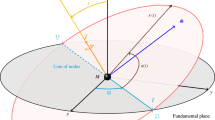Abstract
A new general relativistic many-body effect is described. It results in an unexpectedly large relative acceleration between neighboring test particles that follow an inclined orbit about a rotating mass. The effect vanishes if the orbit coincides with the equatorial plane of the rotating mass. The existence of this effect is due to a small divisor involving the deviation of the orbital frequency measured by a comoving clock from the frequency measured by an inertial clock. The influence of the rotation of the Sun on the Earth-Moon system is investigated, and it is shown that the new effect causes a harmonic variation in the Earth-Moon separation with an amplitude of order 1 m and dominant periods of 18.6 yr, ∼1/2 yr, 1 month, and ∼1/2 month. The confirmation of these results by the lunar laser ranging experiment would provide a significant new test of general relativity and a measurement of the angular momentum of the Sun.
Similar content being viewed by others
References
Holtzmüller, G. (1870).Z. Math. Phys., 69.
Tisserand, F. (1872).C.R. Acad. Sci.,75, 760; (1890).C.R. Acad. Sci.,110, 313.
Thirring, H. (1918).Phys. Z.,19, 33;Lense, J., and Thirring, H. (1918).Phys. Z.,19,156; Thirring, H. (1921). Phys.Z.,22, 29; see also Mashhoon, B., Hehl, F. W., and Theiss, D. S.,Gen. Rel. Grav. (to appear).
Baierlein, R. (1961).Phys. Rev.,162, 1275.
Mashhoon, B., and Theiss, D. S., submittedto Phys. Rev. Lett. (1982).
Marck, J.-A. (1983).Proc. R. Soc. London Ser. A,385, 431.
Fokker, A. D. (1920).Proc. R. Acad. Amsterdam,23, 729.
Schiff, L. I. (1960).Phys. Rev. Lett.,4, 215.
de Sitter, W. (1916).Mon. Not. R. Astron. Soc.,76, 699; (1916).Mon. Not. R. Astron. Soc.,77, 155.
Brumberg, V. A. (1958).Bull. Inst. Theoret. Astron. (U.S.S.R.),6, 733; inReference Coordinate Systems for Earth Dynamics, E. M. Gaposchkin and B. Kolaczek, eds. (D. Reidel, Dordrecht, 1981), p. 283.
Krogh, C., and Baierlein, R. (1968).Phys. Rev.,175, 1576.
Lestrade, J.-F., Chapront, J., and Chapront-Touzé, M. (1982). InHigh-Precision Earth Rotation and Earth-Moon Dynamics, O. Calame, ed. (D. Reidel, Dordrecht), p. 217.
Misner, C. W., Thorne, K. S., and Wheeler, J. A. (1973).Gravitation (Freeman, San Francisco), p. 1116.
Gough, D. O. (1982).Nature,298, 334.
Dicke, R. H. (1982).Nature,300, 693.
Bender, P. L., et al. (1973).Science,182, 229; Williams, J. G., et al. (1976).Phys. Rev. Lett.,36, 551; Shapiro, I. I., Counselman, C. C., III, and King, R. W. (1976)Phys. Rev. Lett.,36, 555.
Author information
Authors and Affiliations
Additional information
This essay received the fifth award from the Gravity Research Foundation for the year 1983 [Ed.].
Rights and permissions
About this article
Cite this article
Mashhoon, B. On a new gravitational effect of a rotating mass. Gen Relat Gravit 16, 311–316 (1984). https://doi.org/10.1007/BF00762188
Issue Date:
DOI: https://doi.org/10.1007/BF00762188




